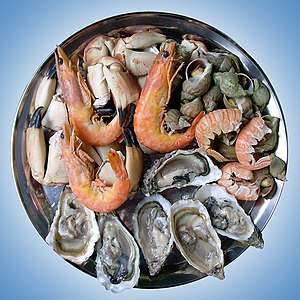Mahi-mahi
The mahi-mahi (/ˈmɑːhiːˈmɑːhiː/)[3] or common dolphinfish[2] (Coryphaena hippurus) is a surface-dwelling ray-finned fish found in off-shore temperate, tropical, and subtropical waters worldwide. Also widely called dorado (not to be confused with Salminus brasiliensis, a fresh water fish) and dolphin, it is one of two members of the family Coryphaenidae, the other being the pompano dolphinfish. These fish are most commonly found in the waters around the Gulf of Mexico, Costa Rica, Hawaii and Indian Ocean.
| Mahi-mahi | |
|---|---|
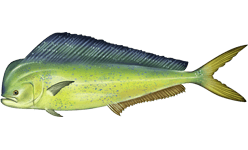 | |
| Scientific classification | |
| Kingdom: | Animalia |
| Phylum: | Chordata |
| Class: | Actinopterygii |
| Order: | Carangiformes |
| Family: | Coryphaenidae |
| Genus: | Coryphaena |
| Species: | C. hippurus |
| Binomial name | |
| Coryphaena hippurus | |
| Synonyms[2] | |
| |
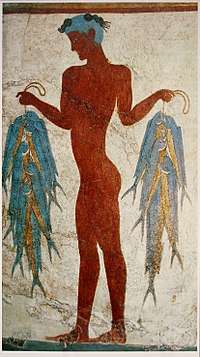
Nomenclature
The name mahi-mahi comes from the Hawaiian language[4] and means "very strong", through the process of reduplication. Though the species is also referred to as the common dolphinfish, the use of "dolphin" can be misleading as they are not related to dolphins; see Coryphaena for the possible etymologies of "dolphinfish". In parts of the Pacific and along the English-speaking coast of South Africa, the mahi-mahi is commonly referred to by its name in Spanish, dorado.[5] In the Mediterranean island of Malta, the mahi-mahi is referred to as the lampuka.
Linnaeus named the genus, derived from the Greek word, κορυφή, koryphe, meaning top or apex, in 1758. Synonyms for the species include Coryphaena argyrurus, Coryphaena chrysurus, and Coryphaena dolfyn.[2]
Description
Mahi-mahi have compressed bodies and a single long-based dorsal fin extending from the head almost to the tail.[6] Mature males have prominent foreheads protruding well above the body proper. Females have a rounded head. Their caudal fins and anal fins are sharply concave. They are distinguished by dazzling colors - golden on the sides, and bright blues and greens on the sides and back. The pectoral fins of the mahi-mahi are iridescent blue. The flank is broad and golden. Out of the water, the fish often change color (giving rise to their Spanish name, dorado, "golden"), going through several hues before finally fading to a muted yellow-grey upon death.
Mahi-mahi can live for up to five years, although they seldom exceed four. Females are usually smaller than males. Catches typically are 7 to 13 kg (15 to 29 lb) and a meter in length. They rarely exceed 15 kg (33 lb), and mahi-mahi over 18 kg (40 lb) are exceptional. Mahi-mahi are among the fastest-growing of fish. They spawn in warm ocean currents throughout much of the year, and their young are commonly found in rafts of Sargassum weeds. Mahi-mahi are carnivorous, feeding on flying fish, crabs, squid, mackerel, and other forage fish. They have also been known to eat zooplankton.
Males and females are sexually mature in their first year, usually by the age of 4–5 months. Spawning can occur at body lengths of 20 cm (7.9 in). Females may spawn two to three times per year, and produce between 80,000 and 1,000,000 eggs per event. In waters at 28 °C/83 °F, mahi-mahi larvae are found year-round, with greater numbers detected in spring and fall.[7] Mahi-mahi fish are mostly found in the surface water. Their flesh is grey-white when raw, cooking to an attractive white with a clean, non-fishy flavour. The body is slightly slender and long, making them fast swimmers; they can swim as fast as 50 knots (92.6 km/h, 57.5 mph).
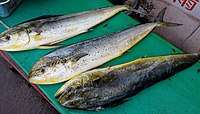 Mahi-mahi in a fish market
Mahi-mahi in a fish market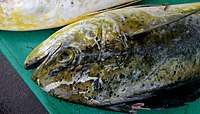 Closeup
Closeup
Recreational fishing
Mahi-mahi are highly sought for sport fishing and commercial purposes. Sport fishermen seek them due to their beauty, size, food quality, and healthy population. Mahi-mahi can be found in the Caribbean Sea, on the west coast of North and South America, the Pacific coast of Costa Rica, the Gulf of Mexico, the Atlantic coast of Florida and West Africa, Indian Ocean, Bay of Bengal, South China Sea and Southeast Asia, Hawaii, Tahiti, and many other places worldwide.
Fishing charters most often look for floating debris and frigatebirds near the edge of the reef in about 120 feet (37 m) of water. Mahi-mahi (and many other fish) often swim near debris such as floating wood, five-gallon bucket lids, palm trees and fronds, or sargasso weed lines and around fish buoys. Frigatebirds search for food accompanying the debris or sargasso. Experienced fishing guides can tell what species are likely around the debris by the birds' behavior.
30-to-50-pound (14 to 23 kg) gear is more than adequate when trolling for mahi-mahi. Fly-casters may especially seek frigatebirds to find big mahi-mahis, and then use a bait-and-switch technique. Ballyhoo or a net full of live sardines tossed into the water can excite the mahi-mahis into a feeding frenzy. Hookless teaser lures can have the same effect. After tossing the teasers or live chum, fishermen throw the fly to the feeding mahi-mahi. Once on a line, mahi-mahi are fast, flashy, and acrobatic, with beautiful blue, yellow, green, and even red dots of color.
Commercial fishing
The United States and the Caribbean countries are the primary consumers of this fish, but many European countries are increasing their consumption every year. It is a popular food fish in Australia, usually caught and sold as a byproduct by tuna and swordfish commercial fishing operators. Japan and Hawaii are significant consumers. The Arabian Sea, particularly the coast of Oman, also has mahi-mahi. At first, mahi-mahi were mostly bycatch in the tuna and swordfish longline fishery. Now, they are sought by commercial fishermen on their own merits.
In French Polynesia, fishermen use harpoons, using a specifically designed boat, the poti marara, to pursue it, because mahi-mahi do not dive. The poti marara is a powerful motorized V-shaped boat, optimized for high agility and speed, and driven with a stick so the pilot can hold his harpoon with his right hand. The method is also practiced by fishermen in the Philippines, especially in the northern province of Batanes, where the harpooning is called pagmamamataw.
Environmental and food safety concerns
Depending on how it is caught, mahi-mahi is classed differently by various sustainability rating systems:
- The Monterey Bay Aquarium classifies mahi-mahi, when caught in the US Atlantic, as a best choice, the top of its three environmental-impact categories. The aquarium advises to avoid imported mahi-mahi harvested by long line, but rates troll and pole-and-line caught as a good alternative.
- The Natural Resources Defense Council classifies mahi-mahi as a "moderate mercury" fish (its second-lowest of four categories), and suggests eating six servings or fewer per month.[8]
- The Environmental Defense Fund classifies mahi-mahi caught by line/pole in the US as "Eco-Best" in its three-category system,[9] but classifies all mahi-mahi caught by longline as only "Eco-OK" or "Eco-Worst" due to longline "high levels [of] bycatch, injuring or killing seabirds, sea turtles and sharks."[10]
The mahi-mahi is also a common vector for ciguatera poisoning.[11] Although a very popular food dish in many parts of the world, there have been reports of ciguatera poisoning from human consumption of this fish. Ciguatera poisoning is caused by the accumulation of toxins in the flesh of the fish over time. These ciguatoxins grow together with marine algae which causes fish like the Mahi-mahi to consume them by accident.[12]
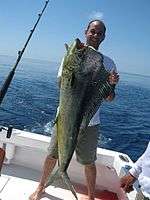 Bull (male) mahi-mahi
Bull (male) mahi-mahi Mahi-mahi are attracted to Sargassum, floating brown algae that serve as both a hiding place and source of food. Lines of this genus can stretch for miles along the ocean surface.
Mahi-mahi are attracted to Sargassum, floating brown algae that serve as both a hiding place and source of food. Lines of this genus can stretch for miles along the ocean surface.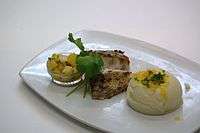 Grilled mahi-mahi
Grilled mahi-mahi
References
- Collette, B.; Acero, A.; Amorim, A.F.; et al. (2011). "Coryphaena hippurus". IUCN Red List of Threatened Species. 2011: e.T154712A4614989. doi:10.2305/IUCN.UK.2011-2.RLTS.T154712A4614989.en.CS1 maint: multiple names: authors list (link)
- Froese, Rainer and Pauly, Daniel, eds. (2019). "Coryphaena hippurus" in FishBase. August 2019 version.
- Dictionary.com: define Mahi-mahi
- Mary Kawena Pukui and Samuel Hoyt Elbert (2003). "lookup of dolphin". in Hawaiian Dictionary. Ulukau, the Hawaiian Electronic Library, University of Hawaii Press.
- "Fish detail". WWF SASSI. Retrieved 2018-05-31.
- Dianne J. Bray, 2011, Mahi Mahi, Coryphaena hippurus, in Fishes of Australia, accessed 07 Oct 2014, http://www.fishesofaustralia.net.au/home/species/1730
- Bostwick, Joshua (2000). "Coryphaena hippurus". Animal Diversity Web. Retrieved August 17, 2011.
- "Consumer Guide to Mercury in Fish".
- "Seafood Selector: Find a Fish".
- "Mahimahi, imported longline, Eco-Worst".
- "Ciguatera Fish Poisoning (CFP)". Fish and Wildlife Research Institute. Archived from the original on 2006-11-25. Retrieved 2010-01-04.
- "Dolphinfish". Florida Museum of Natural History. 2019. Retrieved June 2, 2019.
Further reading
- Atlantic mahimahi NOAA FishWatch. Retrieved 11 November 2012.
- Pacific mahimahi NOAA FishWatch. Retrieved 11 November 2012.
External links
- Froese, Rainer and Pauly, Daniel, eds. (2004). "Coryphaena hippurus" in FishBase. October 2004 version.
- Monterey Bay Aquarium's Regional Seafood Watch
- Blue Ocean Institute's Guide to Ocean Friendly Seafood
- Guide to Fishing Dorado
- Dolphinfish
- Photos of Mahi-mahi on Sealife Collection

